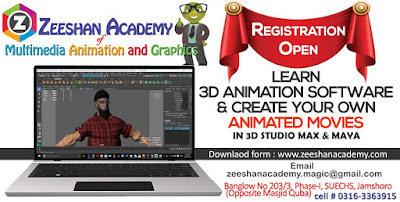Maya Video Training ::.. Lesson 8_ Modeling an LCD (Language Urdu)
Basics of Polygonal Modeling
Polygons are the building blocks of 3D modeling. Just as atoms are the basis of all matter in the universe, polygons are the smallest renderable units that make up a 3D model. Just as atoms can be broken down into smaller particles, a single polygon can be broken down into smaller components. At its most basic level, a polygon is a triangular-shaped face defined by three vertices that are connected by three edges. Any 3D model that you render inside of Maya is made up of polygons,Polygon Anatomy
here are three different types of components in a polygonal object: a vertex, an edge, and a face. Figure below, shows the components of a polygon, which are listed here:• Vertex A point in space. The vertex is the most basic component of a polygonal model.
When Maya stores polygonal data it assigns each vertex in a model a unique identification number and gives that point’s location in 3D space. This information allows the software to reconstruct the model when a file is opened by connecting each vertex to another one with an edge. By editing the position of a vertex, you are changing the shape of the face that it creates.
• Edge The polygonal components that connect two vertices. The area between at least three connected vertices creates a face.
• Face A minimum of three vertices enclosed by three edges. Although you can create a face with any number of vertices, the faces will be broken up into triangles at render time. A triangular face is called a tri, a four-sided face is called a quad, and a face with more than four sides is called an n-gon. The collection of connected faces in a model is called a polygonal surface or a polygonal mesh.
• UV Every vertex in a 3D model can be assigned a coordinate in 2D space. Once the UVs are assigned, they can be edited in the UV Texture Editor to control the placement of a texture map on the 3D model.
• Normal Every polygonal face has a front and a back side. A surface normal indicates the direction of the front of the face. You can display the normal of a polygonal object by selecting the mesh and choosing Display | Polygon | Face Normals. The direction of the normal can be changed by selecting a mesh and choosing Normals | Reverse. A polygonal sphere displaying its normals is shown here:
Video Lecture
In this Tutorial we Lear to Model a simple LCD using Maya Edit Poly Toolslike us and Spread the word
https://www.facebook.com/drzeeshanacademy






